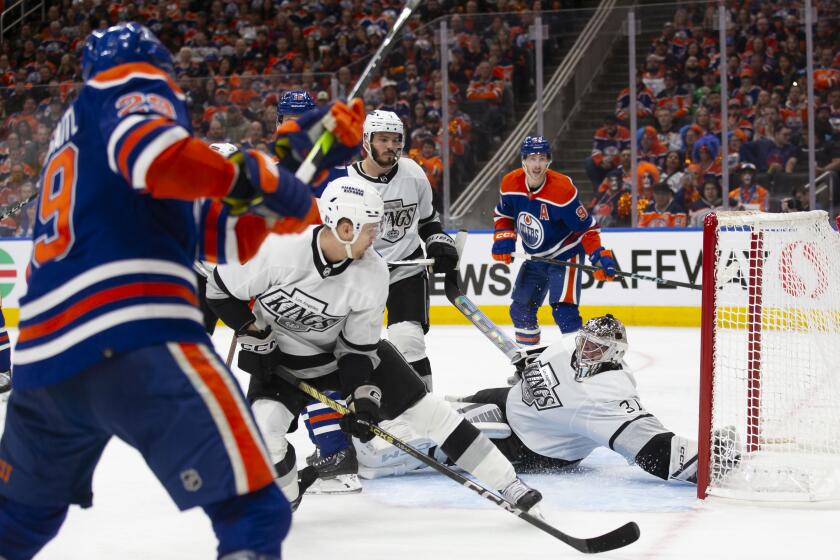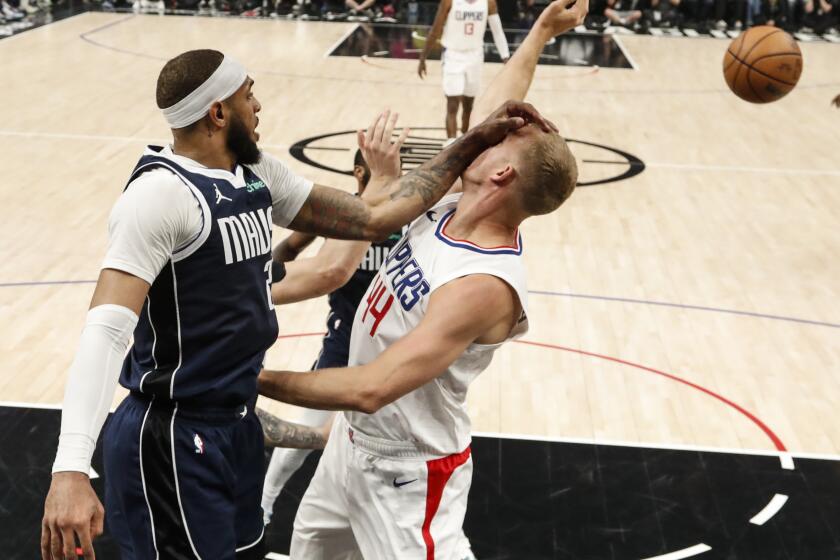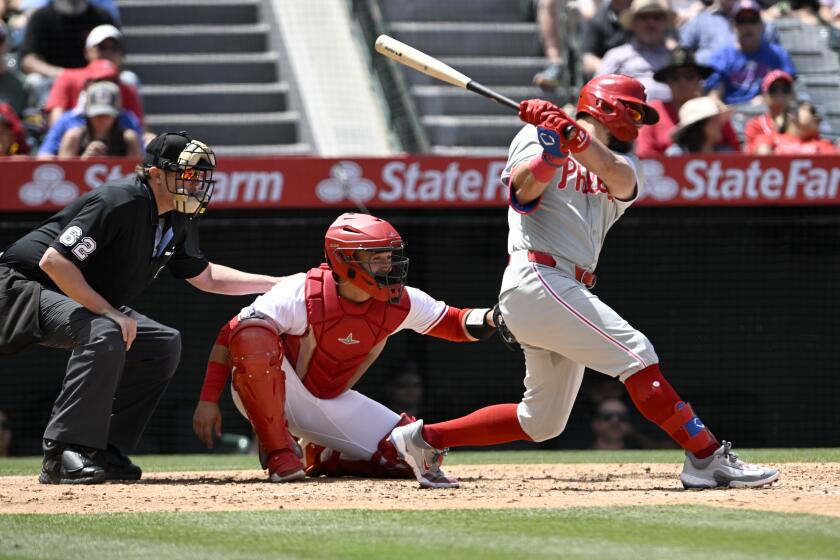Giving Bowl fans the ‘wow’ shot
When New York Giants center Shaun O’Hara and New England Patriots noseguard Vince Wilfork launch their combined 628 pounds at each other in Sunday’s Super Bowl, more than 90 million viewers will be able to almost feel the collision.
And for that they can thank Jim Rodnunsky, a filmmaker from Granada Hills who while working to make his skiing simulator more realistic stumbled upon what experts say is the most significant innovation in sports television of the last 20 years: the Cablecam.
The Cablecam moves on a cat’s cradle of synthetic ropes attached to the light standards atop a stadium, suspending a 65-pound remote-controlled high-definition camera to within 12 feet over the players and 10 yards behind the quarterback.
With it, controllers have the ability to tilt and pan in all directions, snooping in on huddles, gliding along with an injured player as he limps off the field or focusing straight down on a scrum for a loose football -- all from angles previously available only in video games.
“Let’s get right over that goal-line stand and see that guy over the goal line looking up at the camera -- not looking at it, but looking at it -- when he’s just scored a touchdown and he’s on his back with the ball,” said Artie Kempner, the Fox network director who will be calling the shots in Sunday’s broadcast.
“It’s a wow shot. Cablecam gives you the wow.”
Networks still use their sideline cameras for play-by-play action but augment that with Cablecam shots for the more important NFL games. The system isn’t used all the time because of its expense -- use of the camera and the technicians who run it costs about $60,000 a game.
The Super Bowl is well worth that investment, Fox Sports President Ed Goren says.
“The challenge in any sport is to make it more intimate and take the viewer where he hasn’t been before,” he said.
Rodnunsky took some scary risks to get the first overhead shots with his Cablecam prototype. In 1989, he created a version of the cable camera by stringing 1,400 feet of steel cable above Sudan Couloir at Blackcomb Mountain in Canada, one of North America’s most harrowing ski runs.
“It’s a serious piece of real estate,” he said. “It makes Cornice at Mammoth look like a beginner run.”
Rodnunsky, who said he was living on a friend’s couch at the time and subsisting on macaroni-and-cheese dinners, saved $75,000 to build the contraption. He wanted to capture footage for his simulator, which he used to teach people how to ski and snowboard.
Modern Cablecams are gyro-stabilized and controlled by an operator using joysticks in a stadium booth. But Rodnunsky’s rudimentary version required him to take a toe-tingling backward ride.
He built an aluminum basket and would zip face down and feet first down the cable -- attached to rocks at the top and bottom -- reaching speeds of 50 mph and a height of 80 feet, using motorcycle hand brakes to slow his descent.
All while peering through a camera lens.
“Maybe the luge should have been my sport,” joked Rodnunsky, who grew up in Edmonton, Canada, before his family moved to the San Fernando Valley when he was in his teens.
Two years after Rodnunsky’s experiment on the ski slope, Hollywood came calling. Director Steven Spielberg used the Cablecam in 1991 to make “Hook,” and Rodnunsky’s device was later used in commercials, music videos and dozens of movies, among them “Happy Gilmore,” “Miracle,” “True Lies,” “Van Helsing,” “Charlie and the Chocolate Factory” and “Dreamgirls.”
Rodnunsky’s invention has won two Academy Awards for technical achievement in feature films and six Emmy Awards for sports broadcasting. Chatsworth-based Cablecam International now has six cameras, 12 full-time employees and about 75 freelance crew members.
There are competing companies -- filmmaker Garrett Brown is inventor of the Skycam and Steadicam systems; ESPN contracts with Skycam -- but Rodnunsky has contracts with CBS, NBC and the NFL Network in addition to Fox.
Cablecam’s big sports break came in 1994, when it was hired to work the Winter Olympics in Lillehammer, Norway.
That version of the system required two people to ride it, one driving and the other shooting footage. At the end of each day, Rodnunsky recalls local residents gathering at the top of the skiing course to take Cablecam rides at speeds of 60 to 70 mph.
“That was an E-ticket ride, let me tell you,” he said. “They were always disappointed at the end of the day when we had to pack up and go. We were disappointed too.”
Later that year, Rodnunsky’s company used a remote-controlled Cablecam for the Kentucky Derby and Preakness telecasts, although that camera didn’t have the ability to move around in three dimensions as does the modern version.
Rodnunsky’s system was first used in football broadcasts in several college bowl games in 2000. The NFL agreed to the use of overhead cameras in 2003, and it was one of his Cablecams peering at Janet Jackson in 2004 during her infamous “wardrobe malfunction” Super Bowl halftime show.
The Cablecam still has a few bugs to work out, which became apparent during a game early this season when one made an unscheduled landing on the turf.
It was initially reported that the camera nearly clobbered Seattle Seahawks quarterback Matt Hasselbeck, but Rodnunsky said it was a “controlled descent” -- the result of an operator mistakenly trying to move the camera when its motor was turned off. By the next week’s games, lights were added to the top of the cameras to indicate when the motor is running.
Occasionally, punters, kickers and returners have complained that the ball has hit the camera’s support wires.
Fox’s Kempner said the risk of hitting those wires is the main reason Cablecam isn’t used for baseball. So he’s already thinking of the future.
“I would love to have a wireless hovercam,” he said. “The military has drones, and the technology is there.”
More to Read
Get our high school sports newsletter
Prep Rally is devoted to the SoCal high school sports experience, bringing you scores, stories and a behind-the-scenes look at what makes prep sports so popular.
You may occasionally receive promotional content from the Los Angeles Times.







